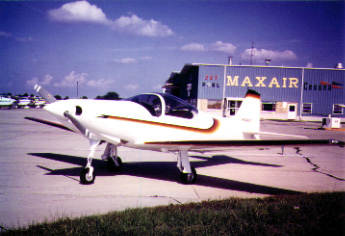First Flight:
Dave Aronson
![]()
First Flight:
|
|
by Alfred Scott
This article appeared in the September 1984 issue of the Falco Builders Letter. |
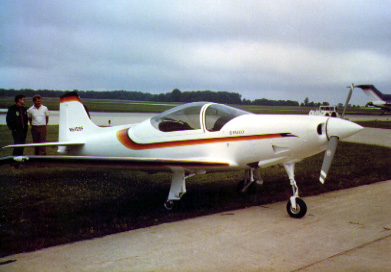
Dave Aronson and Mike Underwood with Dave's Falco.
O Oshkosh! How you ruin my summer! In the three months before Oshkosh, I only had about 5 days that I did not work every day and night. I told Meredith and the girls that they could forget about seeing much of me until Dave Aronson was flying.
And fly he did. Dave flew his Falco on July 20, and we got the Falco to Oshkosh. It is a spectactular airplane... all that we have been striving to make it. There are some problems, and I will take these in turns.
The first problem that surfaced was with the landing gear doors. Dave had installed the full wheel well doors, and due to the wider tire, the geometry changed slightly. I would suspect that this also changed the loads on the linkage. The fitting for the linkage is mounted on the bottom of the wing skin, just under the seats, and it is mounted about halfway between the two seat truack supports. Dave had installed a 10mm block of spruce on the lower surface per the plans, and he had also installed two 20x15 strips of spruce running fore-and-aft bridging the main wing spar and frame No. 5. The entire fitting pulled out of the airplane and left the door hanging. All of the wood broke, and it pulled a patch of plywood out big enough for your head to fit in.
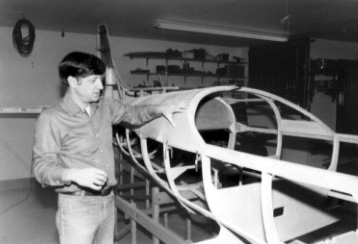
Dave Aronson
I had never given much thought to the wheel well doors. I am not aware of any additional bracing that was installed on the production Falcos that had this door, and Mr. Frati reports that he has never heard of a problem. Still, it is obvious that in Dave's case the wood structure was not adequate. I suggested that Dave rebuild the thing exactly as before and then laminate several layers of Kevlar over the 20x15 spruce pieces. This he did, and it has given no further problems.
After this was fixed, Dave and John Holm continued to fly the Falco. It was a good thing there were two of them in the airplane since on the Tuesday before Oshkosh, they were extending the landing gear and the crank came off! A matter of some embarrassment for all concerned, but John Holm managed to get the gear down by jamming the broked piece down and doing a quarter of a turn at a time. In the process, John got a large blister on his hand which we wore as a badge of a true builder throughout Oshkosh.
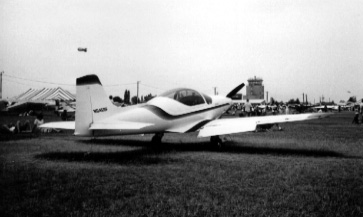
My plan had been to fly to Oshkosn on Thursday, but I flew out to Minneapolis on Wednesday instead, taking with me replacement parts for Dave's Falco. Dave's hangar was swarming with people polishing the airplane--I think there were 15 people in there. It was really something to see the airplane for the first time. It was sitting on jacks, with its nose up high, and in the hangar it looked like something out of the future. Later when I wheeled my Falco into the hangar, it looked really sad next to Dave's. In fact, the airplanes did not look like they were the same design.
Why did the shaft fail? The shafts were originally solid in the production Falco, and I have always been interested in getting as much weight out of the airplane as possible. When we designed the vertical shaft, Dave Thurston and I only considered the torque of the motor. The .049" wall shaft can easily handle the torque of normal retraction and extension of a properly adjusted retraction system. Dave's system was not set up correctly, and they were cranking very hard on the last few turns to jam the gear down. In any event, it is obvious that this sort of thing can happen again, so we are changing the shaft design to a heavier wall tubing and will be sending out replacement parts.
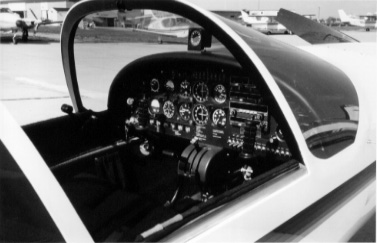
With this installed, we were able to fly the Falcos to Appleton on Thursday night. The next day we flew both to Oshkosh, but not before I got a chance to fly Dave's Falco. (For those of you that are wondering how in the devil Dave flew off all the required 25 hours before Oshkosh and still have time to do all of the repairs, we can only say that we have absolutely no comment on the "Black and Decker Time" rumors that some Falco builders are circulating!)
Now for some comments on flying Dave's Falco. I'm 6' 2", and headroom was not particularly comfortable. Once I released the shoulder belts, I was able to move about more easily. Other than that, the Falco is exceedingly comfortable. I liked the panel as much as I thought I would. The airplane is very quiet. Certainly it is the quietest Falco I have flown in, but it is not as quiet as a Bonanza.
The P-factor on takeoff is quite something. Dave said it was much more than in his A36 Bonanza. We fed in the power quite slowly, and I had no problem. Once I broke ground, I bobbled the airplane around a bit to my embarrassment. Only later did I remember that a large four-engine turboprop had just landed... so it was wake turbulence. Dave had done nothing more than shallow turns by the time I flew it, so I did some stalls and quite a few rolls, both ways until Dave said he wasn't feeling too swift. Not wanting to foul his own airplane, we came back and landed.
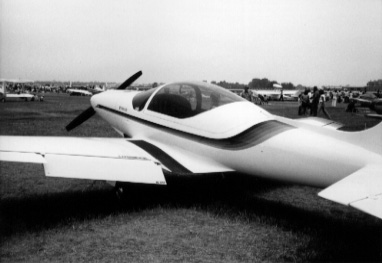
The handling in the air including stalls, rolls, and all control inputs is unchanged--it's a Falco. There are some differences. One is in the slop of the controls. My Falco has all of the bearings worn a bit, and it has a lot of slop, though you don't notice it in the air. Dave's Falco has no play at all. Dave's Falco does have more friction than my Falco, which is as loose as a goose. If you flew Dave's Falco you would problably come to the opinion that it is the nicest airplane you ever flew, but I tell you that it is not the jewel that it can be. Several things are causing this friction, all of which are curable. The bushing on the control hinges have paint on the ends, so you have paint rubbing against paint. One of Dave's projects is to get the friction out of the controls. I don't mean to be critical; most of you would have been ecstatic over the controls. Only someone who has flown a Falco for a long time would notice the difference.
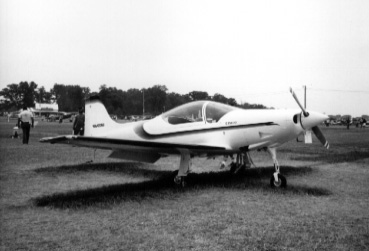
On thing that really impressed me about Dave's Falco was the feeling of riding in it. This is a hard thing to describe, but when you see a Falco you are taken with a feeling of what it must be like to fly in such a lovely thing. Yet, when you actually fly in my old Falco, the cockpit is old and dusty, and it doesn't feel like the beautiful thing you thought it would be. With Dave's, though, you have the feeling that you are flying in the stylish, elegant airplane that you see when you approach it.
Performance? It looks like Dave is now cruising at about 190 mph. He has had it up to 162 kts indicated with full throttle and 2600 rpm, before they finally got the prop governor set. The other day Dave flew on a trip and had 145 knots indicated at 7,500 feet and 23.5/2400, but that was without the wheel well doors installed. On the same trip he saw 202 knots (232 mph) groundspeed on his DME--good for the ego.
